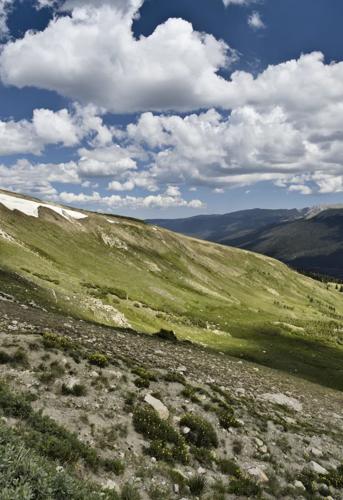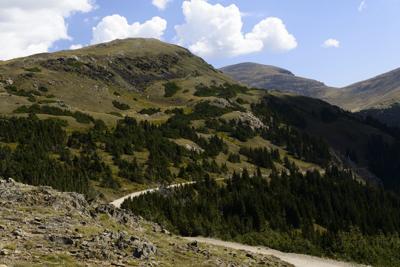Many signs at Rocky Mountain National Park announce Old Fall River Road’s presence, as does the worldwide web, so the path cannot hide, hard as it may try. A dirt lane sneaks up into the forest, a high-altitude escape from the pavement.
NOTE: Check current open status of the road with official park resources prior to planning your trip.
I take it while the vehicles in front of me and behind continue on the pavement. It is that rare moment driving in America’s fourth-most visited national park where traffic is nowhere to be seen. The moment soon will be gone.
On Old Fall River’s initial 3,000-foot ascent, I hear bugs buzzing, smell pine and remember what the ranger said at the visitor center, where Gazette photographer James Wooldridge and I wondered about pull-offs that would allow him to capture the grandeur from the park’s most historic road.
Of course there are pull-offs, the ranger told us. “And there’ll be about nine people ahead of you.”
If the spots were full, there would always be photo ops from the passenger window, we figured. We’d have to go slowly anyway along the one-way road, 8 to 10 feet wide with sheer drop-offs and a 15-mph posting. As for reaching that speed, “Good luck,” the ranger said.
We left the visitor center and headed to the Fall River Entrance, where we waited 20 minutes in one of three toll lines.
The road that set the trend for Rocky Mountain’s motorized mania is far from forgotten. Old Fall River became the park’s first vehicular route in 1920, taking tourists to the panoramic vistas 11,796 feet above sea level. And today the 9-mile, switchback-laden drive remains a favorite for park visitors, which have numbered a record 4 million-plus the past two years.
They take advantage of the road while it’s open in summer, finishing at the Alpine Visitor Center with information about this “land of harshness and beauty,” this tundra that is remarkably accessible, considering its below-freezing temperatures most of the year. Here, trees stand bent and gnarled from blasts of winter wind. Flowers burst for weeks after surviving underground for many months, while the ptarmigan flies year-round thanks to feathered eyelids and nostrils.
Where it seems nature should rule is a gift shop of shirts and shot glasses and a cafe of $10 hamburgers. Visitors observe grainy pictures of convicts and hired hands building Old Fall River Road with the help of horse-drawn wagons. In the crammed parking lot, yellow-vested rangers direct traffic off Trail Ridge Road, “the road in the sky” that in 1932 became the park’s main auto route.

The view from Old Fall River Road in the Rocky Mountain National Park outside of Estes Park, Colorado.
Old Fall River lacks the “elk jams” likely on Trail Ridge. And while the elk are missed, the congestion is not. On this recent Saturday, we pause just once for traffic. An SUV stalled behind us as we attempted to back out of a pull-out, where we stopped to meet a marmot and take in the view: a verdant valley flanked by mountains with craggy sides, snowy sides and stream-fed sides carpeted in green.
A waterfall is the reason for another stop. Beside the silvery rush is a platform where we meet a local woman who’s been driving Old Fall River for years for these close encounters with nature – never mind the selfie-taking crowds around her that have grown every summer.
Rocky Mountain’s visitation has increased 60 percent in 10 years. So goes the trend across the parks system. “Truly wild lands are rare in today’s world, and diminishing every day,” reads a sign at the Fall River Visitor Center. A wall there displays a quote from Enos Mills, the naturalist known as the park’s father: “The Rockies stir one’s blood and strengthen and sweeten life.”
In searching for a campsite or parking spot, the Rockies might make blood boil. Off the road, we find peace in a stroll through a spring-fed meadow bursting with wildflowers. And up ahead we meet only satisfied people returning to the Chapin Pass trailhead, where one couple reports experiencing “the most beautiful thing you’ll ever see” – the journey to Mount Chapin, with the trail linking to Mount Chiquita and Ypsilon Mountain at 13,514 feet. Now they return to their car, one of the many lining this sixth mile of the road.
The views are most spectacular a couple of miles later, where the road skirts the edge of a basin and where a bunch of people have parked. A short, steep hike affords them a clear look at peaks scraping the sky as far as Wyoming.
“This is the ultimate up here,” says a Fort Collins man, another who tells me he frequents Old Fall River. He passes his binocular to others here, imploring them to look at the elk grazing on a distant hillside. Cars proceed as his daughter waves to drivers and points to the animals. She tells them to come see.
“You want to share this,” she says. “It should be shared.”
Old Fall River Road
Construction began: 1913
Distance (one way only): ~9 miles
Elevation gain: ~3,000 feet
Max elevation: 11,796
Scheduled closures to vehicles: Aug. 1, 2, 3 and 17. For the season, Oct. 2.
Getting there: Enter Rocky Mountain National Park through Fall River Entrance. Turn right on Endovalley Road, leading to Old Fall River Road.










(0) comments
Welcome to the discussion.
Log In
Keep it Clean. Please avoid obscene, vulgar, lewd, racist or sexually-oriented language.
PLEASE TURN OFF YOUR CAPS LOCK.
Don't Threaten. Threats of harming another person will not be tolerated.
Be Truthful. Don't knowingly lie about anyone or anything.
Be Nice. No racism, sexism or any sort of -ism that is degrading to another person.
Be Proactive. Use the 'Report' link on each comment to let us know of abusive posts.
Share with Us. We'd love to hear eyewitness accounts, the history behind an article.